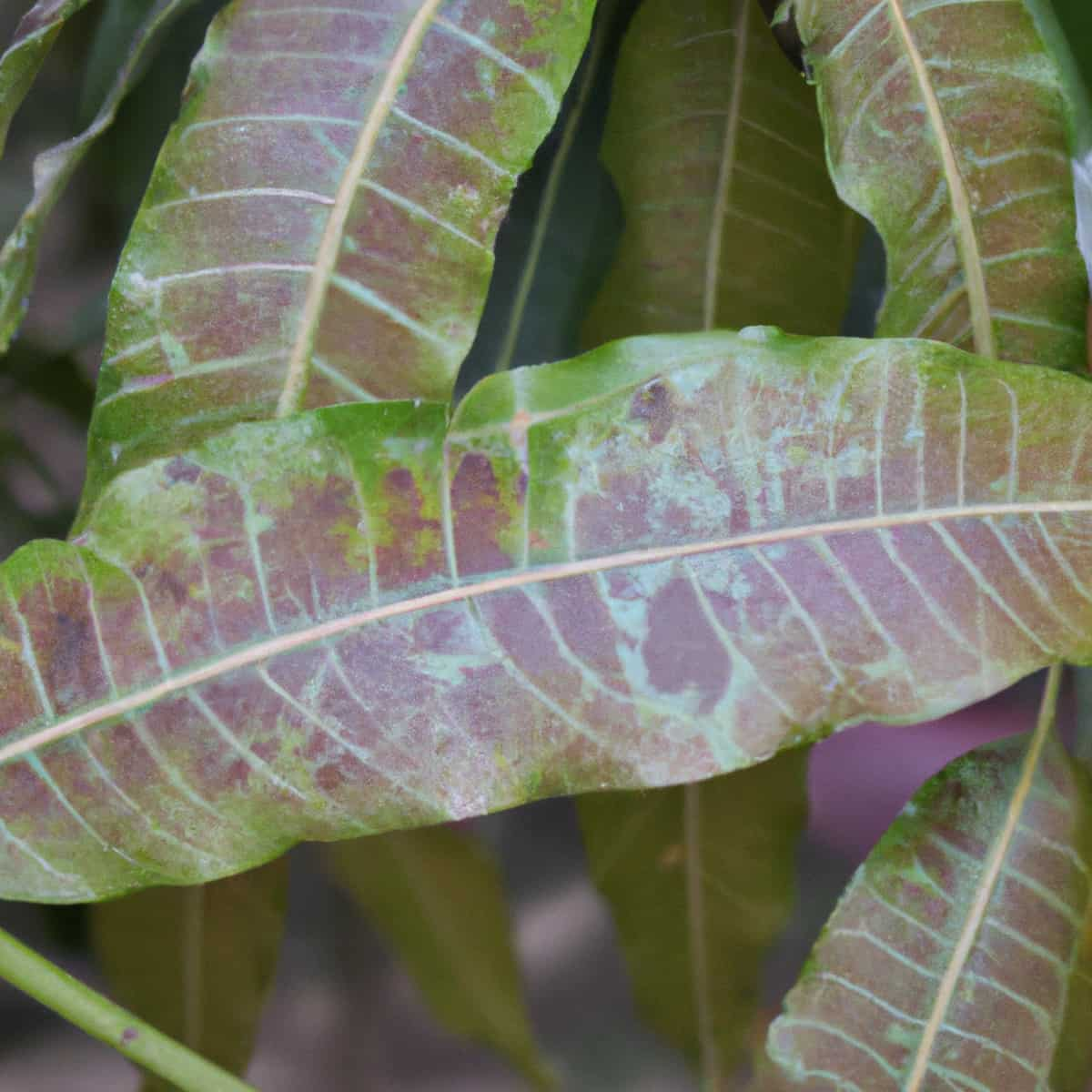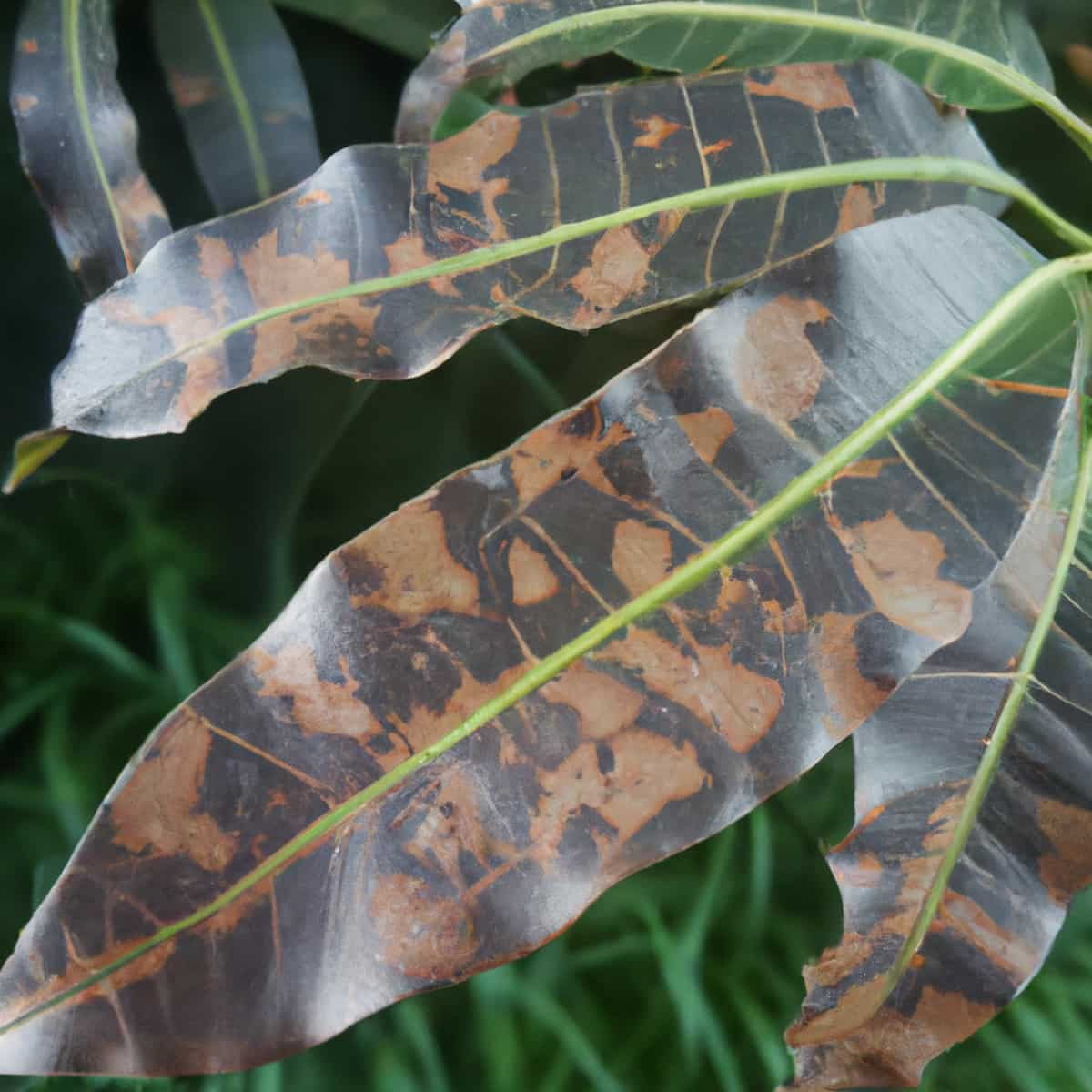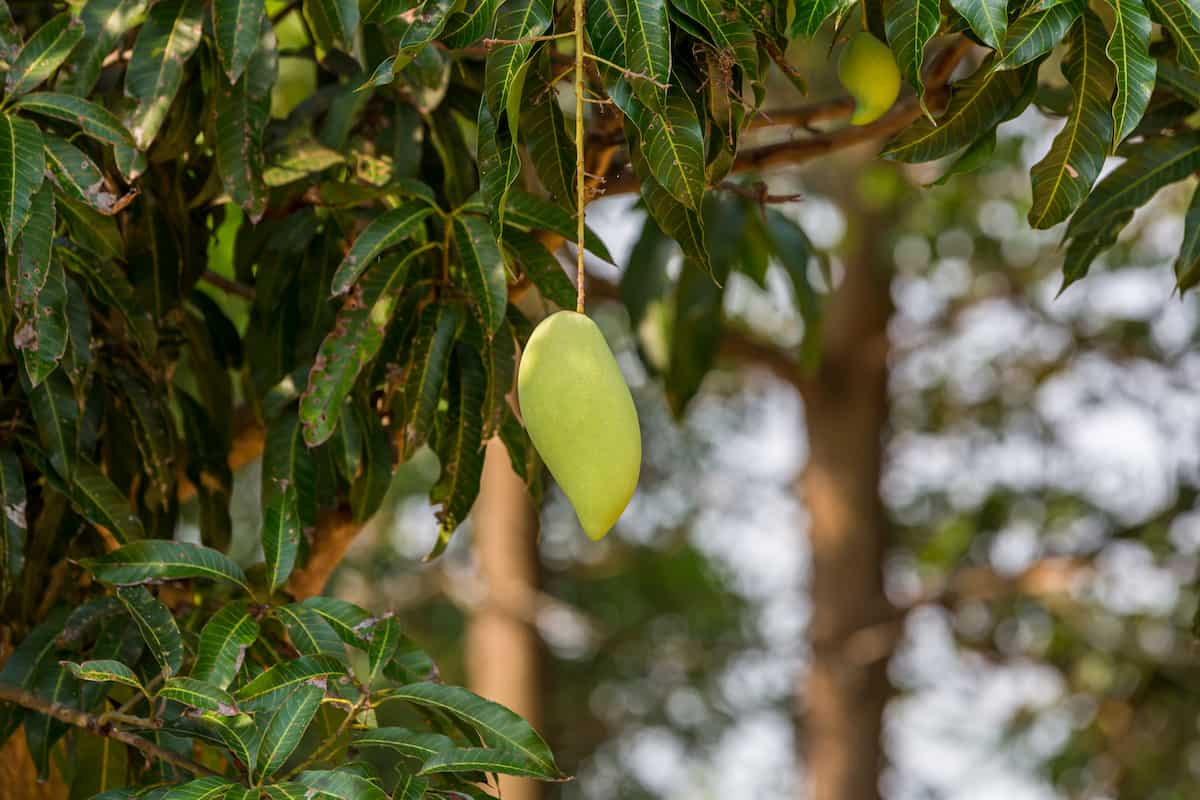The Mango Grey Blight Disease is an important fungal disease caused by the fungus Pestalotia mangiferae. It is one of the most destructive diseases of mango and has caused significant losses in commercial and backyard mango production. The fungus can spread quickly in an orchard through the wind, rain, contaminated tools, equipment, and clothing and infect nearby trees. Cultural practices such as pruning and cleaning up debris from the orchard can help reduce the spread of the disease.

Chemical treatments and biological control measures can also reduce the severity of mango grey blight disease. To effectively manage this disease, it is important to understand its disease cycle, the mode of disease spread, and the best methods for controlling it. This article will provide an overview and discussion of the Mango Grey Blight Disease in Mango crops, including its symptoms, identification techniques, and control.
Mango Grey Blight Disease Management
The Causal Organism of Mango Grey Blight Disease
- Pestalotia mangiferae is an obligate parasite that belongs to the Family Sporocadaceae of Order Xylariales of the Phylum Ascomycota.
- The pathogen is found in the soil, decaying plant material, and other organic matter.
- The acervuli are tiny black spots on the affected plant parts.
- The conidia are small, yellowish-brown to greyish-brown, globose to cylindrical, smooth-walled ascospores released into the air and spread the disease.
The Disease Cycle of Mango Grey Blight Disease
The disease cycle of the Mango Grey Blight Disease, Pestalotia mangiferae, in Mango Crops, begins when the fungus overwinters in infected plant debris, such as leaves and stems, on the ground or in the soil. The fungus penetrates the healthy tissue of the mango tree and produces haustoria, which are structures that absorb nutrients from the tissue. This causes the infected tissue to become grey and die.
During the spring, when the weather warms up, the fungus produces black, oval-shaped, spore-forming structures containing the fungal spores. These spores are then spread by wind and water to the leaves and stems of healthy mango plants. The spores then infect the leaves and stem, causing discoloration and spots.
The infected leaves and stems develop black or grey spots with yellow margins. These spots become larger and eventually spread over the entire leaf. The leaves eventually become dry and brittle and fall off the plant. The fungus then produces more spores that spread to other parts of the plant and nearby plants. This cycle continues until the entire mango crop is infected.
Occurrence of Mango Grey Blight Disease in Mango Crop
- Location of Mango Grey Blight disease: This disease occurs in mango crops in India, Africa, Bangladesh, Sri Lanka, Nepal, Vietnam, Thailand, Malaysia, Indonesia, the Philippines, the United States, Mexico, Brazil, and Australia.
- Host range: The most common crops affected by Pestalotia mangiferae are mango, oranges, papayas, guavas, bananas, tomatoes, and squash.
Favorable Conditions for Mango Grey Blight Disease Spread in the Field
- Hot, humid conditions favor the disease, which is most severe during rainy seasons.
- The temperature range of 20-25°C and high humidity levels, over 85%, are optimal for the germination of the spores.
- The presence of clouds or fog can increase the humidity levels and reduce the evaporation rate, allowing the infection to thrive.
- Poor crop management practices, such as over-fertilizing, pruning, and irrigation, can cause the crop to become weakened and more susceptible to the disease.
- Insects, such as aphids, can act as vectors and spread the disease from one plant to another.
In case you missed it: Mango Red Rust Disease Management: Symptoms, Treatment, Chemical, Biological, Natural, and Organic Control

Damage Symptoms of Mango Grey Blight Disease
- The disease is characterized by small, dark grey spots on the margin & tip of leaf lamina, flowers, twigs, and fruits of mango trees.
- The spots may become larger and develop a concentric ring pattern. Severely infected fruits may become deformed and drop prematurely.
- Symptoms of this disease include dark spots, defoliation, twig & branch dieback of infected mango trees.
- The twigs and branches become weakened and prone to breakage due to dieback.
Percentage of Yield Loss Due to Mango Grey Blight Disease in Mango Crop
- The disease can cause 10% yield losses in the United States. In Mexico, yield losses are 50%. In India, the yield losses range between 40-70%. In Bangladesh, the losses are 15-30%. In China, a 10-25% yield loss is seen. In Thailand, it is 40%.
- In Africa, yield losses are at 20%. In the Philippines, it is 25%. In Brazil, it is up to 60%. In Australia, the losses are 15%. The Economic Threshold Level is determined at around 5-10% of crop defoliation.
Cultural Control Measures of Mango Grey Blight Disease
- Reduce the humidity around the tree by planting crops such as sweet potatoes, peanuts, or maize.
- Prune the trees regularly to remove infected branches and keep the tree free of dead or decaying material that can harbor the disease.
- Rogue out and destroy the diseased plants in the orchards to reduce the disease spread.
- Planting the trees in a well-drained area and avoiding excessive irrigation helps to reduce the amount of moisture in the environment, which prevents the disease from spreading.
- Good sanitation practices should be followed in the orchard, the fallen leaves, debris, and infected plant parts should be removed, and pruning tools should be disinfected.
Biological Control Measures of Mango Grey Blight Disease
- Parasitoid wasp, Aphelinus mangiferae, lays its eggs within the larvae of the pest, and its larvae feed on the pest and ultimately kill it.
- Predatory mites, Typhlodromalus aripo, and the Fungus, Verticillium lecanii, are also used to control this disease. The predatory mite feeds on the pest’s larvae, whereas the fungus causes disease in the pest’s larvae, leading to their death.
Chemical Control Measures of Mango Grey Blight Disease
- Spray Carbendazim after heavy rainfall, followed by wettable sulphur before the flowering stage to control the disease spread.
- Spray other fungicides like Captan, Bordeaux mixture, Chlorothalonil, Copper Oxychloride, or Mancozeb as soon as the disease is observed and should be repeated every 7-14 days until the disease is eliminated.
Organic Control Measures of Mango Grey Blight Disease
- Apply neem oil on the affected plants as a foliar spray and the surrounding area to reduce the chances of the disease spreading.
- Copper sulfate is a natural fungicide that can be sprayed on foliage to combat Pestalotia mangiferae in mango crops.
- Garlic extract is made from crushed garlic cloves, it can be sprayed on the surface of the mango crop, and its antifungal properties help to reduce the spread of the disease.
- Vinegar is an acidic substance that can be sprayed onto the surface of the mango crop against the fungal pathogen.
- Collect the diseased leaves from the orchard and burn them far away from the field to control the disease spread.
Preventive Measures for Control of Mango Grey Blight Disease
- Practice crop rotation with other crops like sorghum, legumes, pearl millet, cotton, etc., for at least two years between mango crop cycles.
- Regularly monitoring the crops for signs of disease will help to find and manage the disease early before it spreads.
- Planting mango varieties that are resistant to the fungus can reduce the spread and severity of the disease.
- Avoid overhead irrigation, as this can cause the spores of the disease to spread.
- Avoid overcrowding by practicing low-density planting of crops in the orchards and avoiding contact between infected and healthy plants.
In case you missed it: Mango Stem End Rot Disease Management: Symptoms, Treatment, Chemical, Biological, Natural, and Organic Control

Conclusion
The Mango Grey Blight Disease, Pestalotia mangiferae, seriously threatens Mango crops. It can cause significant crop losses and has been known to spread rapidly, making it difficult to control. Therefore, farmers must take preventive measures such as regularly monitoring the crop for signs of the disease and using appropriate fungicides to control it. With proper management, the spread of Pestalotia mangiferae can be reduced, and Mango crops can be protected from devastating losses.
- Types of Fungicides Used in Agriculture
- Common Issues in the Fruit Development Stage of Pomegranate Farming
- Fruit Development Issues in Papaya: Easy Solutions and Treatment
- Soil-Borne Diseases and How to Protect Your Plants
- Practices to Prevent Disease Spread in the Garden
- From Wilted to Thriving: How to Treat Root Rot Naturally in Houseplants
- Natural Remedies to Cure Brown Spots on Fig Tree Leaves
- Natural Solutions for Poinsettia Problems: 100% Effective Remedies
- How to Control Calla Lily Problems: Natural Remedies for Leaf and Flower Problems